
By: Dmitri Sedov
Chief Data & Analytics Officer
June 9, 2025
The conversation around sustainability in private markets is undergoing a structural shift. What began as a periodic disclosure requirement is becoming a core component of how firms assess risk, engage with portfolio companies and borrowers, and meet investor expectations.
This shift is particularly visible in private credit, where asset managers must now respond to growing demand from limited partners (LPs) for transparent, decision-useful sustainability data. In parallel, GPs are embedding sustainability criteria into underwriting, monitoring, and reporting processes to better align with risk frameworks and long-term investment strategies.
From Reporting Obligation to Operational Requirement
Sustainability is no longer a sidecar to the investment process. LPs are increasingly requesting data not just for reporting purposes, but to evaluate how managers integrate sustainability into decision-making across the lifecycle from diligence through exit or repayment. These requests often reference established frameworks such as:
- The ESG Data Convergence Initiative (EDCI), which provides a baseline set of comparable sustainability metrics across private equity and increasingly private credit.
- The SASB Standards, offering sector-specific guidance on material sustainability topics.
- The Sustainable Finance Disclosure Regulation (SFDR), influencing disclosure obligations for firms with European investors.
- The Integrated Disclosure Project (IDP) and the IFRS Sustainability Alliance, both of which aim to standardize corporate sustainability reporting across asset classes.
Credit managers are expected to align to at least one of these frameworks or clearly articulate why an alternative approach is more appropriate for their strategy.
Sustainability in Private Credit: Data Expectations Are Rising
In private credit, the application of sustainability data is often more complex than in equity. Lenders may not hold controlling positions, and borrowers vary widely in their ability to track and report relevant metrics. Yet LPs increasingly expect transparency into how sustainability factors are being evaluated, priced, and monitored at the deal and portfolio level.
Examples of this trend include:
- Sustainability-linked loan terms, which may adjust pricing based on borrower performance against agreed sustainability KPIs.
- Covenants tied to emissions, labor practices, or reporting cadence, used to align borrowers with lender expectations on sustainability progress.
- Borrower engagement models, where GPs offer data templates or technical support to enhance reporting quality and consistency.
These practices are still evolving, but the underlying trend is clear: LPs expect credit managers to define, document, and demonstrate how sustainability is incorporated into their investment approach.
Monitoring and Accountability: Post-Investment Expectations
Once capital is deployed, firms must ensure sustainability performance can be monitored over time. This requires systems to collect, validate, and interpret data across large borrower bases or multi-strategy portfolios. GPs are increasingly implementing:
- Portfolio-wide tracking systems or dashboards aligned to frameworks like EDCI or IDP.
- Defined ownership of sustainability oversight—either within deal teams, compliance, or centralized sustainability functions.
- Processes for evaluating data quality, identifying red flags, and escalating issues to investment or risk committees.
While some firms are early in this journey, the direction of travel is apparent: sustainability monitoring is becoming a standard component of post-investment risk management.
Where the Gaps Remain
Despite progress, key challenges remain. These include:
- Inconsistent data quality and coverage, especially among smaller or non-sponsored borrowers.
- Lack of standardized definitions or methodologies for key metrics, particularly those that intersect with industry-specific factors.
- Limited interoperability between portfolio management systems and third-party sustainability data providers.
As a result, many GPs still rely on spreadsheets or manual processes for sustainability tracking limiting their ability to analyze trends, benchmark across portfolios, or respond quickly to investor queries.
The Road Ahead
Sustainability reporting and monitoring in private markets is evolving from a compliance exercise to a strategic enabler. In both equity and credit, firms that can operationalize sustainability data across deal flow, investment decision-making, and portfolio oversight will be better positioned to meet rising expectations from LPs and regulators alike.
Frameworks are maturing, but convergence is still a work in progress. In the meantime, clarity, consistency, and internal alignment will continue to be the differentiators for firms looking to lead on sustainability integration in private capital.
How Allvue Supports the Transition
Allvue supports private credit managers in closing the sustainability data gap. Through its Credit Front Office solutions, sustainability metrics can be integrated directly into deal pipelines, underwriting workflows, and portfolio analysis. This enables managers to track sustainability risk at the issuer level, incorporate relevant factors into pricing and approval processes, and provide investment committees with a more complete, data-driven view of exposure and impact.
For disclosure and reporting, Allvue’s Investor Portal centralizes sustainability documentation within a secure, audit-ready platform. It streamlines delivery to LPs, supporting both SFDR-aligned templates and custom sustainability scorecards. LPs gain on-demand access to relevant data, while managers benefit from a scalable infrastructure designed to adapt to evolving reporting requirements.
With platforms like Allvue, sustainability data becomes more than a reporting requirement; it becomes a source of strategic advantage. To learn more, connect with the Allvue team.
More About The Author

Dmitri Sedov
Chief Data & Analytics Officer
Dmitri Sedov is an accomplished data and product executive with a long-standing track record of driving innovation across financial technology and capital markets. His expertise includes AI strategy, data platform development, and leading analytics transformation at scale. Most recently, Dmitri was SVP and Group Head of Product at LSEG, where he partnered with Microsoft to launch an AI-enabled cloud platform that redefined data access for financial professionals. Prior to LSEG, he held senior leadership roles at Nasdaq, Preqin, and S&P Global, where he led global teams across product, data, and analytics functions. Dmitri is responsible for expanding Allvue’s workflow ecosystem with AI-powered data platforms, real-time analytics, and trusted insights to support smarter, faster decision-making for private capital markets. He holds an MBA from Pace University’s Lubin School of Business and degrees from NYU, University at Albany, and Moscow State University.


